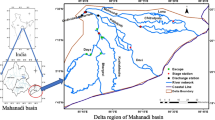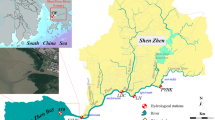Abstract
Flooding remains one of the major natural disasters that threatens human lives and property. Flood management has taken a new look, whereby flood risk in rivers is now viewed as driven by not just climate change but also by river channel morphological adjustment which have been overlooked in the past. This study aimed at evaluating the contributions of channel morphological adjustment to flood risk in rivers using river Elbe in Germany as a case study. To achieve this, an inundation model for the June 2013 flood event was developed using the LISFLOOD-FP model. A total of thirteen additional flood inundation models were ran at varying scenarios of river width, bed elevation and channel friction coefficient under a fixed discharge series. The results of these simulations revealed that, variability in river channel morphology constitutes an integral part of flood risk in rivers, hence a complementary driving factor to flood risk in addition to climate change. Thus, the assumption of a constant river channel morphology during flood modelling should consequently be open to question for flood hazard management. Flood frequency analysis for the Elbe basin was also presented. Discharge data spanning an interrupted period of 61 years (1958–2018) from 10 gauges along river Elbe were analysed for various return periods. It was concluded that any discharge rate having a return period of 5 years (2544 m3/s) and more would likely exceed the water carrying capacity of the Elbe river. The study proposes potential measures for effective flood modelling in rivers and can also serve as important tool for informing and supporting environment related decision making in flood risk management, land use regulation and floodplain management in the study area.
Similar content being viewed by others
Data availability
Available.
Code availability
Not applicable.
References
Ahmad UN, Shabri A, Zakaria ZA (2011) Flood frequency analysis of annual maximum stream flows using L-moments and TL-moments approach. Appl Math Sci 5(5):243–253
Alcamo J, Henrics T (2002) Critical regions: A model-based estimation of world water resources sensitive to global changes. Aquat Sci 64(4):252–263
Alfieri L, Bisselink B, Dottori F, Naumannde G, Roo A, Salamon P, Wyser K, Feyen L (2017) Global projections of river flood risk in a warmer world. Earth’s Future 5(2):171–182
Allen GH, Pavelsky TM (2018) Global extent of rivers and streams. Science 361(6402):585–588
Amarnath G, Umer YM, Alahacoon N, Inada Y (2015) Modelling the flood-risk extent using LISFLOOD-FP in a complex watershed: case study of Mundeni Aru River Basin, Sri Lanka. Proc Internat Assoc Hydrol Sci 370:131–138
Bates PD, De Roo APJ (2000) A simple raster-based model for flood inundation simulation. J Hydrol 236(1–2):54–77
Bates PD, Trigg M, Neal J, Dabrowa A (2013) LISFLOOD-FP user manual for version 5.9.5. University of Bristol
Bhagat N (2017) Flood frequency analysis using gumbel’s distribution method: a case study of lower Mahi Basin, India. J Water Res Ocean Sci 6(4):51–54
Bhat MS, Alam A, Ahmad B, Kotlia BS, Farooq H, Taloor AK, Ahmad S (2019) Flood frequency analysis of river Jhelum in Kashmir basin. Quatern Int 507:288–294
Chang HH (2008) River morphology and river channel changes. Trans Tianjin Univ 14(4):254–262
Chang HK, Tan YC, Lai JS, Pan TY, Liu TM, Tung CP (2013) Improvement of a drainage system for flood management with assessment of the potential effects of climate change. Hydrol Sci J 58(8):1581–1597
Darby SE, Thorne CR (1996) Predicting stage-discharge curves in channels with bank vegetation. J Hydraul Eng 122(10):583–586
Douglas EM, Vogel RM, Kroll CN (2000) Trends in floods and low flows in the United States: impact of spatial correlation. J Hydrol 240(1–2):90–105
Elleder L (2015) Historical changes in frequency of extreme floods in Prague. Hydrol Earth Syst Sci 19(10):4307–4315
Francés F (2004) Flood frequency analysis using systematic and non-systematic information. In: Benito G, Thorndycraft VR (eds) Systematic, palaeoflood and historical data for the improvement of flood risk estimation. Consejo Superior de Investigaciones Cientificas, Madrid, pp 55–70
Groisman PY, Knight RW, Karl TR, Easterling DR, Sun B, Lawrimore JH (2004) Contemporary changes of the hydrological cycle over the contiguous United States: trends derived from in situ observations. J Hydrometeorol 5(1):64–85
Hesse C, Martínková M, Möllenkamp S, Borowski I (2005) Baseline assessment of the Elbe basin. https://www.newater.uni-osnabrueck.de/deliverables/D331_Baseline_Assessment.pdf (Accessed 25 Apr 2019).
Horritt MS, Bates PD (2001) Predicting floodplain inundation: raster-based modelling versus the finite-element approach. Hydrol Process 15(5):825–842
Hunt JCR (2002) Floods in a changing climate: a review philosophical transactions of the royal society of London. Series a: Math Phys Eng Sci 360(1796):1531–1543
IPCC (2001) Climate change: the scientific basis. In: Houghton JT, Ding Y, Griggs DJ, Noguer M, van der Linden PJ, Dai X, Maskell K, Johnson CA (eds) Contribution of working group i to the third assessment report of the intergovernmental panel on climate change. Cambridge University Press
Jacobs P, Blom G, Van Der Linden M (2000) Climatological changes in storm surges and river discharges: the impact on flood protection and salt intrusion in the Rhine-Meuse delta. In climate scenarios for water-related and coastal impacts, ECLAT-2 KNMI Workshop Report, ECLAT-2 workshop, KNMI, De Bilt 3: 35–48.
James A (1999) Time and the persistence of alluvium: River engineering, fluvial geomorphology, and mining sediment in California. Geomorphology 31(1–4):265–290
Kotlarski S, Hagemann S, Krahe P, Podzun R, Jacob D (2012) The Elbe river flooding 2002 as seen by an extended regional climate model. J Hydrol 472:169–183
Kundzewicz ZW, Lugeri N, Dankers R, Hirabayashi Y, Döll P, Pińskwar I, Dysarz T, Hochrainer S, Matczak P (2010) Assessing river flood risk and adaptation in Europe—review of projections for the future. Mitig Adapt Strat Glob Change 15(7):641–656
Lane SN, Tayefi V, Reid SC, Yu D, Hardy RJ (2007) Interactions between sediment delivery, channel change, climate change and flood risk in a temperate upland environment. Earth Surf Proc Landforms J Br Geomorphol Res Group 32(3):429–446
Law GS, Tasker GD (2003) Flood-frequency prediction methods for unregulated streams of Tennessee, 2000. US Geol Surv 3:4176
Lins HF, Slack JR (2005) Seasonal and regional characteristics of US streamflow trends in the United States from 1940 to 1999. Phys Geogr 26(6):489–501
Merz B, Elmer F, Kunz M, Mühr B, Schröter K, Uhlemann-Elmer S (2014) The extreme flood in June 2013 in Germany. La Houille Blanche 1:5–10
Merz B, Kundzewicz ZW, Delgado J, Hundecha Y, Kreibich H (2018) Detection and attribution of changes in flood hazard and risk. In changes in flood risk in Europe (445–468). CRC Press
Middelkoop H, Daamen K, Gellens D, Grabs W, Kwadijk JC, Lang H, Parmet BW, Schädler B, Schulla J, Wilke K (2001) Impact of climate change on hydrological regimes and water resources management in the Rhine basin. Clim Change 49(1–2):105–128
Milly PCD, Wetherald RT, Dunne KA, Delworth TL (2002) Increasing risk of great floods in a changing climate. Nature 415(6871):514
Mirza MMQ (2002) Global warming and changes in the probability of occurrence of floods in Bangladesh and implications. Glob Environ Chang 12(2):127–138
Neal J, Schumann G, Bates P (2012) A subgrid channel model for simulating river hydraulics and floodplain inundation over large and data sparse areas. Water Res Res 48(11).
Osborn TJ, Hulme M (2002) Evidence for trends in heavy rainfall events over the UK. Philosophical Transactions of the Royal Society of London. Series a: Math Phys Eng Sci 360(1796):1313–1325
Pechlivanidis IG, Jackson BM, McIntyre NR, Wheater HS (2011) Catchment scale hydrological modelling: a review of model types, calibration approaches and uncertainty analysis methods in the context of recent developments in technology and applications. Global NEST J 13(3):193–214
Pfeiffer M, Ionita M (2017) Assessment of hydrologic alterations in Elbe and Rhine Rivers Germany. Water 9(9):684
Pinter N, Ickes BS, Wlosinski JH, Van der Ploeg RR (2006) Trends in flood stages: contrasting results from the Mississippi and Rhine River systems. J Hydrol 331(3–4):554–566
Reynard NS, Prudhomme C, Crooks SM (2001) The flood characteristics of large UK rivers: potential effects of changing climate and land use. Clim Change 48(2–3):343–359
Robson AJ (2002) Evidence for trends in UK flooding Philosophical transactions of the royal society of London. Series A Math Phys Eng Sci 360(1796):1327–1343
Roy L, Leconte R, Brissette FP, Marche C (2001) The impact of climate change on seasonal floods of a southern Quebec River Basin. Hydrol Process 15(16):3167–3179
Saksena S (2017) Introduction to flood frequency analysis. Purdue University, Indian. https://serc.carleton.edu/hydromodules/steps/168500.html (Accessed 25th Mar 2019)
Sampson CC, Smith AM, Bates PD, Neal JC, Alfieri L, Freer JE (2015) A high-resolution global flood hazard model. Water Resour Res 51(9):7358–7381
Singer, M. B. 2010. Transient response in longitudinal grain size to reduced gravel supply in a large river. Geophysical Research Letters, 37(18).
Singh UK, Kumar B (2018) Climate change impacts on hydrology and water resources of Indian River Basins. Curr World Environ 13(1):32
Slater LJ, Singer MB, Kirchner JW (2015) Hydrologic versus geomorphic drivers of trends in flood hazard. Geophys Res Lett 42(2):370–376
Smith K (2003) Environmental hazards: assessing risk and reducing disaster. Routledge
Smith K, Ward R (1998) Floods: physical processes and human impacts (382). Wiley
Stover SC, Montgomery DR (2001) Channel change and flooding, Skokomish River Washington. J Hydrol 243(3–4):272–286
Svetlana D, Radovan D, Ján D (2015) The economic impact of floods and their importance in different regions of the world with emphasis on Europe. Proc Econ Finance 34:649–655
Villarini G, Smith JA (2010) Flood peak distributions for the eastern United States. Water Res Res 46(6).
Wilby RL, Beven KJ, Reynard NS (2008) Climate change and fluvial flood risk in the UK: more of the same? Hydrol Proc an Internat J 22(14):2511–2523
Yamazaki D, Ikeshima D, Sosa J, Bates PD, Allen G, Pavelsky T (2019) MERIT Hydro: a high‐resolution global hydrography map based on latest topography datasets. Water Res Res.
Yamazaki D (2019) MERIT hydro: global hydrograph dataset. http://hydro.iis.u-tokyo.ac.jp/~yamadai/MERIT_Hydro/ (Accessed 4th Jun 2019).
Zhou Q, Leng G, Feng L (2017) Predictability of state-level flood damage in the conterminous United States: the role of hazard, exposure and vulnerability. Sci Rep 7(1):5354
Acknowledgements
We would like to thank Prof. S. E. Darby of University of Southampton for guiding the first author to design this work. Our appreciation also goes to Dr. Jeff Neal (one of the developers of LISFLOOD-FP) and Mr. Laurence Hawker of the University of Bristol for their constant guidance in our use of LISFLOOD-FP to run the models for this research. The discharge data used in this study was provided by German Federal Waterways and Shipping Administration (WSV) and communicated through German Federal Institute of Hydrology (BFG). The topographic data (MERIT Hydro) was developed and made available by Dai Yamazaki. The River width data use in this study was provided by Dr. George Allen of University of North Carolina. I sincerely appreciate all your contributions towards the success of this research.
Funding
No funding was received to assist with the preparation of this manuscript.
Author information
Authors and Affiliations
Contributions
The first author (A, EA) initiated the work and carried out all data analysis and writing of this research. The second author (ALAM, MJB) contributed to the data revision and the English correction of the manuscript.
Corresponding author
Ethics declarations
Conflict of interest
The authors have no conflicts of interest to declare that are relevant to the content of this article.
Rights and permissions
About this article
Cite this article
Asinya, E.A., Alam, M.J.B. Flood Risk in Rivers: Climate Driven or Morphological Adjustment. Earth Syst Environ 5, 861–871 (2021). https://doi.org/10.1007/s41748-021-00257-y
Received:
Revised:
Accepted:
Published:
Issue Date:
DOI: https://doi.org/10.1007/s41748-021-00257-y













